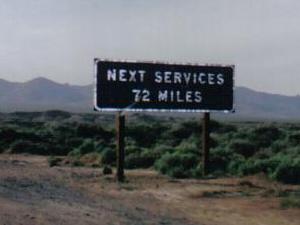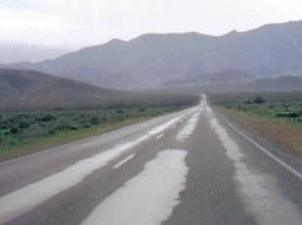« February 2005 | Main | April 2005 »
March 31, 2005
Something Else That Happened in 1994
I was thinking about disliking Microsoft and my argument that early 1994 was when public opinion turned against Microsoft, and it occurred to me that something else happened in early 1994 -- New Year's Day, to be precise. Bill Gates got married.It's not him getting married, particularly. It's the fact that he got married on Lanai and that he booked every hotel room on the island and chartered every helicopter in the state to keep people away. I think this was probably the first time Bill Gates entered the realm of the tabloids, and became noticed by the public as anything other than a smart, rich guy. Now he was a smart, rich guy who put himself apart from the common man. Realize that I completely understand why he wanted his privacy, and I don't personally fault him for it. But that was the first time Bill Gates did anything negative that the general public was aware of, and of course animosity towards Microsoft and animosity towards Bill Gates are commingled in a lot of people's minds.
Posted by AdamBa at 11:25 PM | Comments (0) | TrackBack
March 30, 2005
Microsoft Plumbers
Here's an example of how Microsoft has changed in the last 15 years.It used to be if you clogged a toilet, you would send email to this alias "janfac", and 15-45 minutes later (depending on how many executives had flushed their keys down the toilet that day) a van would pull up, somebody with a plunger would hop out and go to work.
Now, you go to an internal website run by Grubb & Ellis, which we outsource all of our building maintenance to. You wade through pages and pages of forms to finally discover one for bathroom-related issues. You describe the problem ("clogged toilet" is not a specific choice) and then wait. Six days later, you get an email saying that the problem has been resolved.
So I was slightly charmed when I noticed that the hot water handle on the water dispenser in our kitchenette was broken and there was an old-fashioned email alias posted to send problems to. So I sent email. That was 2 months ago and the thing still hasn't been fixed...but at least there were no web forms involved.
Posted by AdamBa at 10:38 PM | Comments (0) | TrackBack
"Honk!" at Studio East
If you are looking for some inexpensive family entertainment, let me recommend "Honk!" at Studio East in Kirkland. This is a fairly new musical based on the story of the ugly duckling. Studio East is a performing arts training program, so all the performers are age 8-18. I've seen the show and they really do a great job (yes, I am related to one of the actors). It's $9 for kids and $11 for adults, in a small theater that seats around 100.Posted by AdamBa at 10:32 PM | Comments (0) | TrackBack
Insanity is Hereditary...
...you get it from your kids.My son came home with the URL of a website that his friend had told him about. This has probably been around the Internet a hundred times, but I had never seen it before. Eek, there's a whole bunch of these things. Now aren't you glad they invented the Internet?
Posted by AdamBa at 10:21 PM | Comments (1) | TrackBack
March 28, 2005
Las Vegas to Death Valley
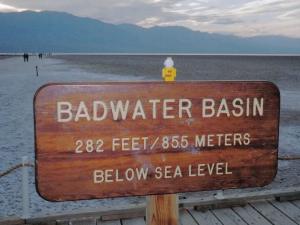
I was in Las Vegas 10 days ago for a hockey tournament, and I had a spare afternoon -- my flight landed at 2 pm, and our first hockey game wasn't until midnight (they run these tournaments almost 24 hours due to lack of ice rinks).
As it happened I had read an article in the paper the previous weekend about how the record rainfall was affecting Death Valley -- causing flowers to bloom in unprecedented numbers. I'm always a sucker for quotes like "Hey, you may not see it this good again in your lifetime".
So, before my flight left from the airport in Seattle I called Hertz, and when I landed in Vegas I picked up my car and immediately headed west.
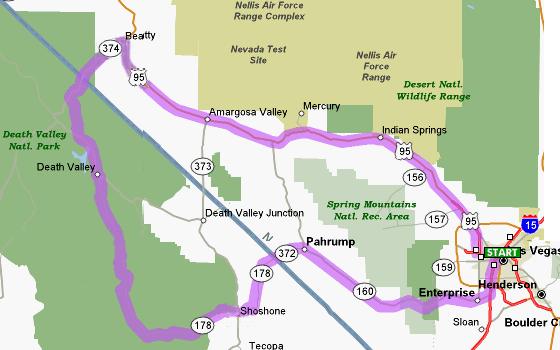
Although Death Valley is one state over, it's not really that far. Since sunset was around 6 pm and the newspaper had said the best flowers were in the southern parts of the park, I headed west on highway 160 to Pahrump, then on 372/178 through Shoshone and into the park.
It's about 100 miles to the park entrance, but the roads are pretty empty and you can blast along at 80 miles an hour most of the way (except when first leaving Las Vegas). The road to Pahrump, which is deserted, has been thoughtfully turned into a four lane road by the Nevada DOT. Far be it from me to speculate, but it is true that Pahrump is just over the border in Nye County, which means bordellos are legal there. So perhaps the highway was widened to allow people to get to their "dates" just a bit faster?
In any case, you do get to Pahrump, then after missing the turn off for 372 the first time, you wind up on a truly deserted road, leaving you to ponder the strangeness of experiencing such solitude in the middle of a Las Vegas vacation.
Once you get to the park, as promised, you see some excellent floral displays. I had never been to Death Valley before, but it's usually just scrub desert, not scrub desert with millions of flowers.
At first I was just seeing lots of individual flowers, but then as I got a bit further north, there were some incredible vistas where entire fields or hillsides were yellow from the flowers (the photo below is from the west side of Jubilee Pass, just like the article said). I gather that these are normally plain brown and green. The flowers are so cool that you forget how stunning the scenery behind them is. There were lots of cars stopped at the side of the road with people staring ga-ga-like, and also several photographers with fancy cameras on tripods. So I predict in a little while you will be able to buy some nice photos of Death Valley in bloom.
Hertz had thoughtfully provided me with a zippy little Mazda 6, which was an invigorating companion on the park road (the road is paved, but it's one of those where they didn't spend a lot of time smoothing out the ground underneath, so there tend to be lots of nice ups and downs).
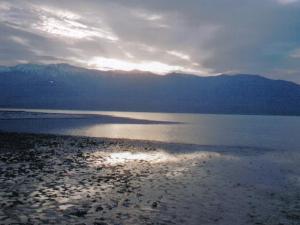 At 143 miles from the Las Vegas airport, 2 1/2 hours after I left (including various stops for photos along the way), I reached Badwater, the lowest point in North America.
As promised, there was a giant lake there. I got a nice photo of the sun setting over Telescope Peak, the highest point in the park. Where the lake is there is normally wierd dried salt formations; right at the lowest point there is a sign indicating a small pond that is usually the only water around. There is no place for the water to flow away from Badwater (which I guess makes sense since any place it exited to would need to be lower), but normally Death Valley is so hot that almost all the water evaporates.
At 143 miles from the Las Vegas airport, 2 1/2 hours after I left (including various stops for photos along the way), I reached Badwater, the lowest point in North America.
As promised, there was a giant lake there. I got a nice photo of the sun setting over Telescope Peak, the highest point in the park. Where the lake is there is normally wierd dried salt formations; right at the lowest point there is a sign indicating a small pond that is usually the only water around. There is no place for the water to flow away from Badwater (which I guess makes sense since any place it exited to would need to be lower), but normally Death Valley is so hot that almost all the water evaporates.
Badwater has a small boardwalk and then a path you can follow that leads to the salt formations (or the lake, in this case). You can walk to the edge of the lake, but with the water there it was more like a gradual transition from terra firma to spongier and spongier ground.
From Badwater I drove north to Furnace Creek, where the visitor's center is. I arrived 15 minutes after it closed, so I could not pick up a pamphlet (which has one of those excellent maps [warning: slow-loading PDF link]). The way I drove it was 160 miles from the LV airport to Furnace Creek. I was planning to drive east on 190 to Death Valley Junction on my way back, but discovered that the road has been washed out due to a storm; instead as the light faded I drove north towards highway 374 and the town of Beatty, NV. Now I was back on US 95, the main line from Reno to Las Vegas, although at night it was just another two-lane road, where I could drive for 20 minutes without overtaking another car. I drove on through Amargosa Valley, aware that Yucca Mountain was slumbering to my left, and beyond that Area 51. Eventually the road widened to four lanes, and it was a straight shot back to Vegas, 155 miles from Furnace Creek via the northern route.
Posted by AdamBa at 09:12 PM | Comments (0) | TrackBack
March 27, 2005
Bungie's New Home
Bungie, the game studio that makes Halo for Microsoft, is moving to some new digs in Kirkland.The King County Journal article I linked to says their new office will be at 424 Kirkland Ave. It's the abandoned hardware store which is at the south end of the Kirkland Parkplace mall -- right next to the Kirkland Performance Center, and a couple of blocks from the Google office.
Kirkland is a more happening town than Redmond, with a waterfront and some good streetfront stores, but this is not the most happening part of Kirkland. The mall has a movie theater, 24 Hour Fitness, pretty good independent bookstore, Noah's Bagels, and TGI Friday's, but it's four blocks from the water (not that far, although it puts it on the far side of downtown Kirkland, which isn't that big). The place also doesn't have a view, it's lower than the road next to it. On the plus side, it's a block from the Kirkland Transit Center (and the city was actually considering building a transit center on the new Bungie site). And I'm sure once they get done gussying it up it will be very nice inside.
Posted by AdamBa at 08:42 PM | Comments (2) | TrackBack
March 26, 2005
Disliking Microsoft
In an early version of chapter 2 of their blogging book, Robert Scoble and Shel Israel wrote, "Since the late 1970s, Microsoft has been perceived as a company at war with competitors and governments, whose products have been scorned almost as universally as they have been adopted."I don't think this is true. Consider the beginning of the year 1990. Windows 3.0 had not shipped; Microsoft was selling DOS and working on the next version of OS/2 with IBM. In word processing, spreadsheets, database, and networking, it was far behind an entrenched competitor. Visual Basic had not shipped, and its development tools were weak. Microsoft was being sued by Apple over the "look and feel" of Windows, but the case involved the extent of a license that Microsoft had signed with Apple, not accusations of out-and-out theft (and Apple at the time was also a much larger company than Microsoft). The US Federal Trade Commission was also investigating Microsoft over allegations that it had conspired with IBM to limit features in Windows in favor of OS/2, but that wasn't yet public knowledge.
So I think it is safe to say that in early 1990, Microsoft was not seen as being at war with competitors (and certainly not at war with the government), and its products were considered adequate in some areas and deficient in others, but were not "scorned" on general principle. In addition, Microsoft was seen as a "cool" company among college seniors.
Jumping ahead to the end of the decade, on November 5, 1999, after a very long, very public trial, Judge Thomas Penfield Jackson ruled that Microsoft was a monopoly, a ruling greeted with much rejoicing in the software industry.
So Microsoft's reputation went south somewhere in the 1990s. But when, exactly?
Let's review some of the legal timeline:
- 1988 - Apple sues Microsoft over Windows "look and feel".
- March 1991 - FTC investigation of Microsoft becomes public.
- April 1992 - Apple lawsuit ruling in favor of Microsoft.
- Jan. 1993 - Stac Electronics sues Microsoft, claiming planned disk compression software in DOS 6.0 infringes on its patents.
- February 1993 - FTC, on a 2-2 vote, takes no action in Microsoft investigation.
- August 1993 - US Department of Justice takes over the FTC investigation, looking into OEM licensing of Windows.
- February 1994 - Microsoft ordered to remove disk compression software from DOS 6.0.
- June 1994 - Microsoft settles with Stac for $83 million.
- July 1994 - Microsoft signs consent decree with Department of Justice.
- February 1995 - consent decree thrown out by Judge Stanley Sporkin.
- August 1995 - Judge Thomas Penfield Jackson re-approves the consent decree.
- July 1996 - Caldera sues Microsoft, claiming it used Windows to thwart DR-DOS.
- September 1996 - Department of Justice begins investigating Microsoft for unfair competition with Netscape.
- October 1997 - Department of Justice sues Microsoft for violating the consent decree by bundling Internet Explorer with Windows.
- May 1998 - Department of Justice and 20 states file antitrust suit against Microsoft.
I'll stop there; there was various legal maneuvering, from the Department of Justice, some states, and Sun, trying to get injunctions to prevent the shipment of Windows 98. The DOJ case continued on (here's a timeline up to the November 1999 ruling; I also discuss this in some more detail in chapter 13 of Proudly Serving My Corporate Masters). In April 2000 Judge Jackson ruled that Microsoft had violated antitrust laws, and 2 months later announced he was splitting up the company, etc. Somewhat unnoticed in there was Microsoft settling the Caldera lawsuit in January 2000. But anyway, it's obvious that by 1998 a lot of people hated us and thought we were forcing crappy software on unwilling consumers.
Of course, Microsoft had been disgruntling various constituencies throughout the years. The divorce with IBM over OS/2 (in September 1990) annoyed a lot of software developers who had invested in OS/2, and the subsequent push that Windows 3.0 gave to Microsoft applications created a legion of conspiracy theorists. Related to this were the "OS/2 vs. Windows" arguments after IBM took over OS/2 and improved it significantly.
But looking at the timeline, 1994 stands out as the year that things went south for Microsoft. The Apple lawsuit was a licensing issue, the FTC investigation looked laughable by the time it became public (since by that point Microsoft and IBM had split up over OS/2), the initial DOJ investigation into OEM licensing seemed somewhat esoteric, and just the fact of Stac suing us was not such an image hit (little companies sued big companies all the time).
In 1994 the rulings started to go against Microsoft: the Stac judgement created the public perception that Microsoft was stealing from others (and the fact that we later settled just made us look more guilty), and then signing the consent decree with the government again created a "where there's smoke, there's fire" impression.
Here's another angle: In January 1994 the cover of Wired was Douglas Coupland's short story "Microserfs" (which later became a book of the same name), which presented a sunny, happy view of Microsoft. Three months later the cover story was "Oh No, Mr. Bill" (which later became part of the book The Microsoft File), which talked about Microsoft's antitrust struggles (and the book was even more negative). At the end of 1994, a recent Microsoft college hire named Hadi Partovi sent email to Steve Ballmer, detailing the negative impression that most of his classmates had of Microsoft, and how this was hurting recruiting.
So it looks like the spring of 1994 was when the worm turned.
Posted by AdamBa at 09:20 PM | Comments (3) | TrackBack
March 25, 2005
Statistically Improbable Phrases
I was looking at the amazon listing for the book Debugging by Thinking and on the listing it has the "Statistically Improbable Phrases" (a self-referential term if I ever saw one) for the book. For example "debugging tactics". If you click on that it shows you other books with the same phrase, and then further clicks shows you where it appears in each book.This is from an explanatory page from amazon: "Our computers scan the text of all books in the Search Inside program. If they find a phrase that occurs a large number of times in a particular book relative to how many times it occurs across all Search Inside books, that phrase is a SIP in that book."
You can actually enter any phrase into it with some trivial MBA-applicant-style URL tweaking. For example if I search on my name, it comes up with a bunch of references. Unfortunately they are all bogus (or someone else). My name somehow wound up on a list of sample names that Microsoft Press uses for books. I need to nag Addison-Wesley to get Find the Bug into Search Inside, so it will show up here.
You can have fun with this. I can track down the precise reference for the phrase "what cavemen used to debug fire" that I used a couple of days ago. Or find all books that refer to "Robert Scoble". Or "squeamish ossifrage" or "throbbing genitalia" or "naked lacrosse". Let's say you decide that any book with the phrase "dripping honey pot" in it belongs on your night table. Now you can find them. Or it actually, since there is only one right now. That makes it a "sipwhack".
I feel like a little kid again, typing "eat boogers" into a Unix shell so that I can laugh at the response "I don't know how to eat boogers".
Posted by AdamBa at 12:05 PM | Comments (0) | TrackBack
March 23, 2005
The Bug Hunter
This is a little interview about the book I did for TechRepublic (not sure how it wound up on CNETAsia). I'm most proud of slipping in the line "what cavemen used to debug fire" which is straight out of The Soul of a New Machine (an oscilloscope is described the same way, when compared to a logic analyzer).When I was doing some research for Proudly Serving My Corporate Masters, I read a "where are they now?" article about the TSOANM crew, and discovered that Jim Veres, one of the engineers from Data General, was working at Microsoft at the time. I sent him email and he was kind enough to answer my question (about Craig Mundie's role in the whole thing).
Posted by AdamBa at 04:51 PM | Comments (0) | TrackBack
March 22, 2005
Someone Comes to Town, Someone Leaves Town
That is the title of Cory Doctorow's new novel. According to Amazon's listing it won't be out until my birthday.Here's an excerpt from the blurb: "Alan understands. He himself has a secret or two. His father is a mountain; his mother is a washing machine; and among his brothers are a set of Russian nesting dolls."
The reason I am postoing any of this is because the title of the book reminded me of Dhalgren. The only problem with this hypothesis is that it would imply that more than one person had actually read that book, which isn't likely to be true.
Perhaps if I slap in some links to Doctorow's site, he will see this and reply.
Posted by AdamBa at 02:53 PM | Comments (1) | TrackBack
March 21, 2005
Review of "Juiced" on Slashdot
I wrote a review of Jose Canseco's book Juiced for Slashdot. It did generate some discussion of the bio-ethics angle, but most of it was about "WTF is a sports book being reviewed on Slashdot."In his testimony last Thursday, Canseco said he did not advocate steroid use. For whatever reason it seems he is attempting to finesse the public on what he said in the book. But there's no doubt that his statements there were a dramatic change from the book, where he says steroids are good for you if used properly.
Posted by AdamBa at 11:09 PM | Comments (0) | TrackBack
EMP, RIP?
There was a report today in the Seattle P-I about the Experience Music Project, a museum in Seattle bankrolled by Microsoft co-founder Paul Allen. The EMP is the crazy-looking building at the Seattle Center, designed by Frank Gehry (the building also houses the Science Fiction Museum, including the new home of the Sci-Fi Hall of Fame).The articles are about how the EMP is five years old, is losing money and customers, and may go out of business. That scenario may be a bit far-fetched, but no question that the museum has not been successful as had been hoped. The most interesting point that the article makes is in this quote: "Whereas most non-profits tend to sprout from small, grass-roots efforts, EMP just sort of appeared, wholly formed, on Seattle's doorstep". It's true. There was no local music movement that scrimped and saved to built the EMP and now feels devoted to it. Paul Allen, who is a big fan of rock music in general and Jimi Hendrix in particular, simply willed it into existence.
I have been to the EMP a few times. It's interesting and the exhibits are technologically well-done, but we go to the museums that our kids like, and it doesn't appeal to them yet. For one thing it is too loud. They like Odyssey and MOHAI and the Children's Museum and the Pacific Science Center, and sometimes the Zoo or the Aquarium or Imagine if we feel like making the drive.
But Seattle does have a thriving music scene, certainly more thriving than Cleveland (for popular music, anyway), and you would think the city could support the EMP.
Posted by AdamBa at 10:13 PM | Comments (5) | TrackBack
March 16, 2005
Balanced Regex Matching in .Net
This one made my head hurt. .Net supports regular expressions that can detect unbalanced parenthesis (long the bane of regular expressions). Actually it's unbalanced anything, here is Ryan's example for angle brackets:
<[^<>]*(((?<Open><)[^<>]*)+((?<Close-Open>>)[^<>]*)+)*(?(Open)(?!))>
.Net has super-hectic regular expression support, but I wasn't aware of this.
Posted by AdamBa at 04:58 PM | Comments (1) | TrackBack
March 15, 2005
March Madness on MSN Search
What Christopher Payne mentioned in his talk last week is now up. Search for "March Madness" on MSN Search and the top of the results has some direct links to NCAA basketball tournament information. For exanple at this moment (4:23 PM) it shows the score of the Oakland - Alabama A&M play-in game, with a link to Fox Sports coverage. You can also search on individual player names like "Chris Paul" to get stats, or the name of a team like "Kentucky Wildcats" to get tourney information on them (don't include the double quotes in the search, or it won't work).They seem to have everyone on all the rosters, so even "Josh Grier", a freshman benchwarmer on the Delaware State Hornets, has his moment in the sun. And if you search for "Stephen King" right now, the first result might not be what you expect.
Posted by AdamBa at 04:22 PM | Comments (0) | TrackBack
March 11, 2005
Breakfast Series on MSN Search
One of the myriad benefits of working at Microsoft is the "Breakfast Series" of talks from executives. Not only do they serve Krispy Kreme donuts, but you get some decent insider scoop.Today I went to hear Christopher Payne, VP of MSN Search, talk about status and future plans. Nothing earth-shattering, but it was interesting to see him point out some of the features of Search. For example did you know it can solve equations? Which reminds me that it still somehow feels like magic when you actually plug in the value for x. I mean sure, you learn how to solve (x^2 - 5x + 6) = 0, of course it's x = 2 and x = 3. But then you actually plug it in...9 - 15 + 6 is 0! 4 - 10 + 6 is 0! Incredible.
Anyway, Payne also pointed us to the MSN Sandbox, where Microsoft has some beta toys like the MSN Newsbot. MSN Search is also doing some tie-ins to the NCAA basketball tourney, where you can type team and player names to get stats and scores, but I'm not sure how you get to that (perhaps it's not publicly available yet).
At one point during the demo Payne unintentionally showed us directions to his boss's house. Search really is powerful! I wonder what the threat model for a search engine is like. Maybe you have Information Non-Disclosure threats.
Posted by AdamBa at 02:50 PM | Comments (0) | TrackBack
March 10, 2005
Ray Ozzie New Microsoft CTO
Microsoft is buying Groove and installing Ray Ozzie as CTO.Haven't seen any internal email about this yet.
Posted by AdamBa at 08:26 AM | Comments (1) | TrackBack
March 09, 2005
Hackers
This is a quote from the article from boston.com about what the rejected Harvard Business School applicants did: "This behavior is unethical at best -- a serious breach of trust that can not be countered by rationalization." It also used the words "hack", "hacker", or "hacking" twelve times.Meanwhile, this is a description of what the quote-unquote hackers actually did. It's basically grab a GUID from a URL, look in the HTML page source for an embedded 7-digit number, and combine those into the parameters to a .asp page.
OK, so obviously this wasn't something you could do accidentally; people were intentionally doing something to get information they knew they weren't supposed to have yet. But this is "hacking"? Please. I know I have personally done that kind of URL tweaking on websites, and I bet I would have done it if I had been an HBS applicant. Does this mean I am ethically lacking? Who knows. To me the fact that it was information I was going to receive anyway, and it was so easy to get, makes it OK, but obviously if I have ethical issues than I can't trust my own judgement. What is more annoying is that these people are being demonized as "hackers", which is a complete misuse of the term. And HBS is doing this to bolster their case for denying admission. How is that ethical?
Philip Greesnpun discuss the ridiculousness of this; it also came up on Slashdot. Here's a post from one of the 119 people who "hacked in", who said he was rejected anyway.
Posted by AdamBa at 10:23 PM | Comments (0) | TrackBack
March 07, 2005
Trashing Infospace
The Seattle Times is in the middle of a 3-part story, accusing Infospace's former management of being stock-price-manipulating crooks. Part 1, "Dubious Deals" was yesterday, and today we had Part 2, "Insiders flee". This is really bad stuff if it is true, and makes Martha Stewart's alleged misdeeds seem minor. You've got executives struggling to pump up earnings with shady deals, asking to be demoted so they could sell their stock, equivocating in analyst presentations...here's an article about the legal hoops they had to go through to unseal court documents.There was a side story about people making lots of money and buying damn-fool crap with it. One guy dropped $100K in a Dodge Viper, then spent $150K more to send it to Hawaii to have a custom paint job on the hood. Wait, it gets better, because the web version of the article has a link to photos of the car, which the guy is trying to unload. Here's a close-up of the dolphins. The thing was painted by Christian Riese Lassen, whose ads were all over the tourist magazines when we were in Hawaii -- he specializes in that unique brand of schlock nature art that people only seem to buy when on vacation.
The guy also wanted some bling-bling so he started designing rings: "His first creation featured a 4-carat diamond surrounded by gems representing the colors of the flags of France, his heritage, and Italy, his Ferrari's." He made a ring symbolizing the union of his car and himself? Does that mean he, like, married his car?
Posted by AdamBa at 03:22 PM | Comments (0) | TrackBack
MarkL on Shipping
Ex-MSFTer Mark Lucovsky, now at Google, posted his thoughts on how shipping software has changed. This has been discussed everywhere. I'm not sure what the fuss is about. His basic point (his only point) is that shipping to the web is faster than shipping as packaged software. Yeah, no shit. In fact this point is so obvious that I wonder if it was posted for some other reason. Wierd initiation ritual into Google? We'll see if next week Mark shaves his head and sticks it in a toilet.Everyone and their brother squawked at this and pointed out that Microsoft ships stuff to the web too, so Mark posted a followup, which said he wasn't trashing Microsoft, just pointing out that shipping has changed.
It would be similar to going to a record company that sells CDs and saying, "you guys don't understand how to sell music anymore, stamping CDs and sending them to stores has a big lead time, I can sell it on the web and get it out there so much faster". It's true, but it ignores the fact that a) lots of people still want to buy CDs and b) the fact that people have been buying CDs for a while is one of the things that enabled you to sell music over the net. In fact it's a bit more direct than that since the software you use to connect to the web (OS, browser, etc) is part of the packaged software that allows for the internet experience -- if all CDs disappeared tomorrow you could still sell music over the net, but if all packaged software was wiped off of people's machines, you couldn't run web-based software.
Posted by AdamBa at 03:10 PM | Comments (0) | TrackBack
March 05, 2005
My Idea for Podsearching
One of the reasons I can't see podcasting catching on is because you can't search them.I'm sure people are working on transcribing the audio and doing searches on that, but I had an idea that may work better than that.
If you listen to the radio, you may notice that different types of radio stations tend to have announcers with similar voices. For example on "The End" (107.7) in Seattle, all the DJs have that slacker tone of voice. If I asked you to imitate the stereotypical DJ from a country station, or a college station, or an alternative station, or a conservative talk radio station, or an easy listening station...you could probably do a pretty good job.
So when you are in a strange city, hunting the dial for a station you like, a good indicator is whether the announcer sounds like the announcer on the station you like at home.
So my idea is about how to find new podcasts you might like, given that you have a certain set you subscribe to already. My theory is that you can analyze the voice on a podcast, without interpreting what the words mean, and come up with a set of numeric values that represent the talk/music ratio, the intonation of the speakers, the speed at which people talk -- things like that. We'll call this the "Barr rating" of a podcast. If every podcast site posts its Barr ratings also, you can quickly scan all podcasts out there, and give a listen to the ones whose Barr rating are close to the Barr ratings of podcasts you already subsribe to.
What I like about this is that you don't need to do the speech-to-text conversion; I'm sure reasonably appropriate audio algorithms exist already. It won't let you search the podcast for specific "search terms" in the sense that search engines use them, but in fact you don't want to have something that reactively searches for podcasts; you want something that proactively finds podcasts you might like. And this idea actually leverages what is different about podcasts vs. blogs -- the fact that podcasts do have audio, and all the extra information that can be conveyed that way.
Posted by AdamBa at 10:21 PM | Comments (0) | TrackBack
Unintentional Bug in "Find the Bug"
Astute bug-finder Ian Spence reported the first genuine, could-have-been-the-one-I-intended bug in Find the Bug. It's the third item on the newly-updated errata page. As I wrote there, "this bug is precisely the kind of one I was trying to include in the book, and it would be completely reasonable of someone reading the program to think they had found the bug if they found this one."Posted by AdamBa at 09:35 PM | Comments (0) | TrackBack
Google's Lost Naming Opportunity?
I wonder if Google would have named themselves differently if they knew they were going to become part of the language. Just think, they could have named themselves gorange, gilver, or gurple.I was think about this and wondering if there was any previously work that rhymed with kugel. But of course there was: googol.
Posted by AdamBa at 09:31 PM | Comments (0) | TrackBack
March 04, 2005
OSC Students Visit Microsoft
A few weeks ago the students from Sea-Tac OSC (which I discuss here) came to visit Microsoft, with me as their host.Microsoft came through here. I contacted the Microsoft Visitor Center (formerly known as the Microsoft Museum; it's still in Building 127, underneath the Company Store) just to check if it was OK to bring 40 student by. Not only was it OK, but they organized a treasure hunt in the museum for the students, and gave out games as prizes. Community outreach like this really does make me proud to work at Microsoft.
The Visitor Center is open to the public and is worth visiting if you are in the neighborhood (if not, here's a page with some information for students). They've got a Microsoft timeline, various "neat" Microsoft products to play with, etc. In one area they had 2 Xboxes with Halo 2. The students seemed pretty familiar with that.
Elsewhere on campus they were at a demo that included a shared whiteboard app -- the students each had tablet PCs and the union of whatever ink they drew was displayed on a big screen. It took the students about two seconds to figure that out, then about two seconds more to figure out that there was no way to trace the writing back to individual people. Then about two seconds more to discover they could scribble ink over each other's words. And then about two seconds later, the whole screen was solid black.
The chaperones were a bit horrified at this, but actually I did the same demo with a bunch of Microsoft employees and we did the exact same thing (the kids just figured it out a bit quicker). Of course we were drawing happy face pictures, not writing "PIMP" over and over.
Posted by AdamBa at 09:12 PM | Comments (0) | TrackBack
March 02, 2005
Origins of MS-DOS
Tim Paterson, who wrote the operating system QDOS on which the original PC-DOS and MS-DOS was based, is suing the author of a book which claims that QDOS was a ripoff of CP/M.Microsoft legally acquired QDOS; the issue is whether Paterson had earlier "ripped off" CP/M when writing QDOS. It's not clear what exactly "rip-off" means; there's no doubt that QDOS looked like CP/M, because most command-line-based OSes back then looked the same (and still do; Monad on the surface looks a lot like CP/M, QDOS, PC-/MS-DOS, and any Unix shell). The exact story of how IBM came to use a Microsoft OS instead of CP/M on its original PC, and where that Microsoft OS came from, has been told many times in many ways. I know Kildall felt that Gates violated a gentleman's agreement that Microsoft would sell languages and Digital Research would sell operating systems; rumors about the origins of QDOS just add fuel to the fire. Kildall is dead, Don Estridge is dead, Sir Bill ain't really talking, and the "truth" may never be known.
(Actually there's another story floating around about this, which is that Microsoft "ripped off" Tim Paterson because they made so much money off of his baby, but Paterson eventually went to work for Microsoft, and I don't think there are any holes in his shoes today).
There is absolutely no doubt, however, that wherever QDOS came from, Microsoft took the ball and ran with it in terms of enhancing, marketing, and evangelizing PC-DOS and MS-DOS. I discussed this in my first book, and it's actually one of my favorite sections, so with all modesty I am going to post a link to it: start reading at the bottom of p. 186 and go to p. 192. As it says at the end:
"Selling it cheaply, having the hardware manufacturers present it as the standard, making it 'fun', attacking the competition on technical issues, not porting applications to competitors' systems, making sure that its developer tools ran only on its operating systems, signing up potential competitors as partners, talking about a 'family' of operating systems--these are all techniques it would use later with Windows. And above all, the most important one, evangelism: getting out there and selling other software developers on its operating system, explaining why everyone was going to be developing for it and they should to."
Posted by AdamBa at 11:14 AM | Comments (3) | TrackBack
March 01, 2005
Spa
While at the Grand Wailea, of course I had to check out the spa, which is renowned world-wide (or so they say).There are actually two spas, one for men and one for women, which as far as I can tell (from the pictures, and from talking to my wife) are essentially identical. You sign up for a massage or whatever, but then they give you an hour beforehand to explore the various hot tubs they have. The pictures on the page linked to above show some of that (except you have to subtract the half-naked hot spa babes and add in completely naked dumpy spa guys). The picture at the top shows the "Hawaiian bath" which is a giant hot tub, next to a small cold plunge (60 degree pool for freezing your yayas in). Then below that the small picture shows the 5 "Terme baths", which are tubs of various warmth, containing water with different kinds of dissolved goop (seaweed, mud, etc) which turns them interesting colors, as you can see. You sit in each of the baths for 5 minutes while the water works its healing/soothing/recalibrating magic, and then briefly wash off in the "Swiss Jet Shower", aka the car wash, that has about 50 nozzles shooting high-pressure water at you for 30 seconds. Below that is a picture of the "Cascading Waterfall Massage", where a big stream of water gushes down on your cranium for 5 minutes -- a bit painful for my tastes, although some people love it.
There's also a sauna and steam room, and a Japanese bath and cold plunge (the difference from the Hawaiian bath is that the Japanese one has nozzles bubbling water up from the floor, instead of shooting in from the sides). My favorite was to alternate between the steam room and cold plunge. Gets your skin a-tingling.
The Pro Club, the gym that Microsoft gives all its Redmond employees a free membership in, remodeled a few years ago and added its own fancy spa. The literature when they were building it claimed that it was inspired by the Grand Wailea spa (and also the spa at Bellagio)...having now experienced the GW, I can say that the lobby of the Pro Club spa may have been inspired by it, but the actual facility falls short. It's very nice, but there's no Terme this or Cascading that.
Posted by AdamBa at 11:05 PM | Comments (0) | TrackBack

